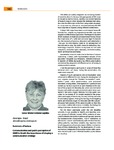Please use this identifier to cite or link to this item:
http://www.alice.cnptia.embrapa.br/alice/handle/doc/1068025| Title: | Communication and public perception of GMO in Brazil: the importance of shaping a communication strategy. |
| Authors: | CAPALBO, D. M. F.  |
| Affiliation: | DEISE MARIA FONTANA CAPALBO, CNPMA. |
| Date Issued: | 2016 |
| Citation: | In: INTERNATIONAL CITRUS CONGRESS, 13., 2016, Foz do Iguaçu. Sustainable citriculture: the role of applied knowledge: abstract book. Campinas: IAC; Londrina: IAPAR, 2016. |
| Pages: | p. 182-183. |
| Description: | The GMOs are widely cropped in an increasing number of countries. Brazil is the second largest grower of GM crops in the world, next to the US, planting 42.2 million hectares of biotech crops in 2014. Despite the relatively high adoption rates the GM crops are far from being widely accepted. In many countries, attempts to introduce and establish GM food crops led to disputes among different stakeholders. In Brazil GM crops have been a controversial issue differently from neighboring Argentina where GM crops were adopted in 1996 without opposition. The illegal introduction of GM soybeans in Brazil was an experience that has shown the importance of a solid and workable legal frameworkand the necessity of previous discussion with stakeholders - not just the ones directly linked to the development of the trait and or crop, like public research institutions, biotechnology companies, farmers, to say some, but also with consumers, consumer rights advocates, environmentalists, health professionals and media. Quantitative research conducted at the time of intense controversy in Brazil, with representative samples of the population instigated by Greenpeace, revealed broad publicrejection of GMOs. But quite a few efforts were made to understand the viewpoints of different sectors of society in relation to GM products. I had the privilege to participate in some of those few initiatives and I will share, during the presentation, the experiences acquired Aspects of public perception and communication were addressed in different formats during the development of such projects: manual for ?Problem Formulation?, stakeholders? panel, online questionnaires, semi structured interviews, among others. One experience in particular was carried out by four countries in Latin America in the context of the project LAC Biosafety (5), where environmental impacts and public perception/communication were partnered in the same project. Demand from the public consulted in the context of this project resulted in the preparation and supply of brochures, courses, training and even TV and radio programs. Among the training, those targeting media professionals sought to stimulate scientific culture - empowerment process of the general public so that they can obtain credible information on GMOs, facilitating the taking of personal decision (in its various formats). For the Brazil case-study under the LAC Biosafety umbrella, it was possible to identify and describe: common groups of attitudes toward GMOs; patterns of association between the common attitude groups and variables like socioeconomic characteristics, trust in institutions asinformation sources and familiarity with the Brazilian biosafety authority; how these variables play important rolesin defining patterns of attitudes toward GMOs; the implications of these relationships for the development of a communication strategy plan that would promote public awareness and stimulate a well-informed Brazilian public debate on biosafety. All experiences and achievements in those research projects had their impact and recently we got the opportunity to multiply the experience, adapt it and expand it to other countries - Kenya and Uganda. By sharing the experiences of Brazil and research fi ndings with those countries, it is expected that they can move forward in the decisions on GMOs in accordance with their own principles and desires, but not losing sight of the science that gives base to advance safely. Some lessons learned over our work: (*) cooperation between groups of technical and scientific research and the groups of communicators is key to effective communication of best available science; (*) the characterization of stakeholders (their desires, trust and interest) is essenti al for an effective communication plan; (*) interest groups are similar but the power structure is different for each country; (*) the understanding of the power structure is key to define the better way to assure a delivery of scientific facts for the decision-making process. Brazil has a great opportunity to lead the use of GMOs in agricultural production in their energy opti ons and other markets, such as climate issues or biomass. Legal certainty translated into accurate regulatory processes, efficient and based on the best science is the key to develop this potential. |
| Keywords: | OGM |
| Type of Material: | Resumo em anais e proceedings |
| Access: | openAccess |
| Appears in Collections: | Resumo em anais de congresso (CNPMA)  |
Files in This Item:
| File | Description | Size | Format | |
|---|---|---|---|---|
| 2016RA014.pdf | 166.8 kB | Adobe PDF |  View/Open |









